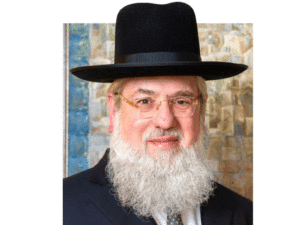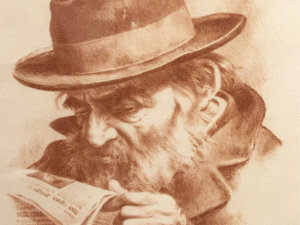Just last week, when we sat at the Seder, we joyously thanked Hashem (in Lefichoch) for bringing us from mourning to Yom Tov, and suddenly we are thrust once again into the aveilus of Sefirah. Although some do not initiate the mourning period until Rosh Chodesh Iyar, the Arizal taught that this entire period is fraught with sadness. It therefore behooves us to explore the source of this grieving and what we should do to attempt to rectify its effects upon us. Interestingly, even the Torah we learn during this time period may be connected to the tragedy, it has been suggested that (Rav Dovid Cohen, Birkas Yaavetz 2:257;Toldoson Shel Avos, Pesicha, page 7) we study Pirkei Avos now to learn how to avoid and correct the causes of the cataclysm that afflicted our nation long ago.
As we all know, Chazal (Yevamos 62b) teach us that “Rebbi Akiva had twelve thousands pairs of talmidim who perished during one time period because they did not give honor to each other.” The Gemara a bit later reveals that this time period was the days between Pesach and Shavuos, about which there is a well known disagreement concerning the details. However, almost all meforshim express difficulty in understanding and articulating what the great Tannaim, the disciples of Rebbi Akiva, actually did to deserve the horrific punishment that resulted. In fact, not only was the human aspect of the tragedy so great – 24,000 tzaddikim gone in just a few weeks – but the Gemara concludes that the “world was desolate of their Torah.” Rashi explains this to mean that “the Torah was forgotten.” The magnitude of the catastrophe is incomprehensible, but no less the severity of the sin. We will attempt, with the help of several of the gedolei hadoros, to reflect upon what occurred and what we may glean for our own avodah.
A number of Torah giants have taught us that the key to this enigma is a comparison between the Gemara’s and the Medrash’s version of what led to the great tragedy. The Medrash (Kohelles Rabbah 11:10 and Bereishis Rabbah 61:3) states that “after all 24,000 of Rebbi Akiva’s talmidim passed away, he gathered seven new students and warned them, ‘My first talmidim died because einam tzarah baTorah zeh lazeh – they were miserly in their attitude toward each other’s Torah. Do not be like them!’ Immediately, the entire land became filled with Torah.”
Several questions arise. Do the Gemara and Medrash contradict each other or are they somehow connected? How could the land fill up with Torah “immediately”? Surely, the loss was so immense and irreplaceable, it should have taken years or decades to be restored to some semblance of what was.
Rav Aharon Kotler zt”l (Mishnas Rav Aharon 1:66) teaches that since Rebbi Akiva was the fount and matrix of Torah Shebaal Peh — the entire Oral Law – every aspect of the mesorah of the Torah had to be perfect. The Torah is acquired by 48 methodologies (Pirkei Avos 6:6), amongst which are the principles of ideal personal middos. Once there was a gap in this transmission, the entire system imploded and there was no justification for the further existence of those who should be teaching Torah to the next generation.
Rav Yechezkel Levenstein (Ohr Yechezkel, Middos 4:23) goes even further. He asserts that initially, in the throes of the tragedy, Rebbi Akiva did not fully comprehend the reason for his students’ demise. The Gemara refers to his initial reaction, but the Medrash reveals his later analysis, when he was able to come to terms with what had occurred.
Rav Chatzkel explains the inner rationale for what seems to be an astonishing lapse in the middos of the holy Tannaim who had achieved the lofty status of being talmidei Rebbi Akiva. Rabbeinu Yonah (Shaarei Teshuvah 3:147) warns sharply about the sin of disrespect toward talmidei chachomim. The disciples of Rebbi Akiva spent their entire lives scrupulously running from any semblance of honor or glory. This approach to personal repudiation of kavod spilled over into at least a modicum of lack of respect for their peers as well, since all sought the ultimate goal of eradicating any pleasure or enjoyment of the detested kavod. Rav Chatzkel reports that there actually was an approach to such repudiation in the mussar city of Kelm, where no titles whatsoever were utilized in calling someone up to the Torah. This was indeed to minimize any yearning for kavod of any sort.
Rav Boruch Mordechai Ezrachi (Birkas Mordechai, Mussar 3:282) relates an amazing story he heard from his father-in-law, the great mashgiach, Rav Meir Chodosh. The Alter of Slabodka zt”l spent the last years of his life in Tel Aviv, surrounded by a number of his close talmidim, including Rav Chodosh. The Alter’s physicians wanted him to eat a certain cereal that they deemed beneficial to his health, but for some reason it did not agree with the Alter. His loyal students were beside themselves with concern and worked hard to prepare an enhanced version of the cereal. Finally, one of the talmidim announced with great relief, “Boruch Hashem, I have succeeded. I added some ingredients. Now the cereal looks and tastes much more appetizing. Rebbi will soon be feeling much better.” The time for the much-awaited meal arrived and the new “chef” presented his dish to the Alter with a wide smile of anticipation on his face. The Alter lifted the spoon to his mouth and was about to taste the innovation, but he suddenly began to scream, “Poison! Poison! Why do you want to poison me? Throw it out!” The talmidim, especially the one who had worked so hard to concoct the new cereal, could not fathom what had happened. Then the secret was revealed.
Chazal (Bereishis Rabbah 1:5) teach that one dare not enjoy the fruits of someone else’s downfall. The young man who had first prepared the original cereal would feel like a failure. Even the well-meaning new cook was inwardly celebrating his triumph, but it was at someone else’s expense. To the Alter, that was poison.
Rav Ezrachi thought he found a source (Menachos 68b) for the Alter’s reaction, but he concludes that this is what it means to be absolutely meticulous about not taking any pleasure in someone else discomfiture.
Rebbi Akiva’s talmidim, on their exalted level, should have been more careful of even a hint of miskabed b’kolon chaveiro, enjoying or even tolerating someone else’s spiritual loss.
Rav Chaim Kanievsky was asked a series of questions about this matter and his answers (Derech Sicha, Behar, page 394) shed light on many of these questions. The first was: Why doesn’t the Gemara state that Rebbi Akiva had 24,000 talmidim? Why use the cryptic phrase “12,000 pairs”? The answer: They were chavrusos.
Reading a bit into Rav Chaim’s answer, we can understand that the problem stemmed from their relationship as chavrusos. Everyone is familiar with Rav Chaim’s terse responses, which must be studied carefully. It was their interaction with each other in Torah that caused the problem.
The next question: Was this indeed a grave sin that could result in such a dreaded result?
Rav Chaim now speaks a bit more expansively: “They were to be the leaders of the next generation. Since people were going to emulate their lapse in middos, there was no other way but what actually happened.”
The third question: Why didn’t they do teshuvah and why didn’t Rebbi Akiva admonish them?
The answer: Rebbi Akiva himself was unaware of the reason for the decree. First of all, it is clear from the Medrash (Koheles 11:6) that Rebbi Akiva only realized the reason later on. Secondly, the students thought they were acting correctly, as long as they had not actually been disrespectful to each other.
We see that Rav Chaim, too, follows in the footsteps of the baalei mussar we quoted earlier. However, perhaps Rav Chaim’s most profound chiddush in this matter is his answer to the fourth question: When they saw that the talmidim were beginning to die, why didn’t they do teshuvah? Rav Chaim responds that “the decree had already been sealed and their teshuvah did not help, so that future generations would learn the bitter lesson. Regarding the term ‘immediately,’ where the Medrash records that after Rebbi Akiva began teaching his new seven talmidim, the land became filled with Torah, one must ask: Did they build yeshivos immediately? Surely not. However, the very fact that they fully accepted Rebbi Akiva’s words did indeed fill the land with Torah.”
Rav Chaim is demonstrating to us here both the severity of the sin of not respecting our fellow Jews enough and, on the other hand, how even a commitment to improve can change everything immediately.
We cannot leave this subject without carefully reading a line from the Chofetz Chaim. He writes in his Sefer Zechor L’Miriam (page 49) that the true trigger for the terrifying punishment of Rebbi Akiva’s talmidim was that “despite their immense greatness in Torah, their lack of proper mutual respect caused a tremendous chillul Hashem, which brought the middas hadin – Divine Justice – upon them, causing them all to die. The Chofetz Chaim is helping us look beyond the surface sin to the harmful fruits of their actions. Torah scholars must adhere to higher standards because any aberration in their behavior creates a tidal wave of spiritual devaluation in the populace. To get just a tiny sense of this process, we need only note the lowering of moral standards when presidents and other officials have engaged in improper behavior. All the more so when great tzadikim falter in their interpersonal middos, even with the best of intentions.
Finally, Rav Chaim Friedlander (Sifsei Chaim, Moadim 3:45) reconciles the Gemara and the Medrash by suggesting that the Gemara describes the actual sin while the Medrash goes to the heart of the cause of the transgression. To conclude with an example of Rav Chaim’s optimistic vision that even the worst of decrees can be rectified, we must recall the uplifting story of Reb Boruch Ber Leibowitz, rosh yeshiva of Yeshivas Kamenitz and author of Birkas Shmuel. His selflessness under the most difficult of circumstances (see Rabbi Paysach Krohn, In the Path of the Maggid, page 36) is a testament to what a person can achieve in the world of middos.
Rav Boruch Ber had a daughter who had been experiencing difficulties finding an appropriate shidduch. Finally, a fine bochur from the yeshiva was suggested, they became engaged, and the chosson was showered with the expensive gifts common in those days. To help shield the chosson from distractions during the engagement period, Rav Boruch Ber suggested that the chosson learn elsewhere in the interim. The chosson accepted the idea, but a few months later, a package arrived at the rosh yeshiva’s house with the gifts the chosson had received with a note indicating that the engagement was off. Obviously, the kallah was devastated, since there had been no indication of any coming changes and the entire family was shattered. After several years, Rav Boruch Ber received a note from the erstwhile chosson informing him that he was seeking a rabbinic position and required a letter of recommendation. Rav Boruch Ber sat down to write the letter, but also assembled three bochurim from the bais medrash, asking them to review the letter.
“You all know of the young man who became engaged to my daughter and then broke the engagement,” said Rav Boruch Ber. “He has now asked me for a letter of recommendation to a position for which he is applying. I am afraid that because of the pain that is still in my heart, I may not do him justice, so please read this letter carefully to make sure that I have not shortchanged him because of my subjective feelings.”
The three bochurim read the letter carefully and confirmed that no more praise could have possibly written by anyone else, thus satisfying the rosh yeshiva’s mandate. Surely such sentiments and actions are the kind that can reverse decrees such as that which resulted in our Sefirah aveilus and can hopefully bring Moshiach as well.








